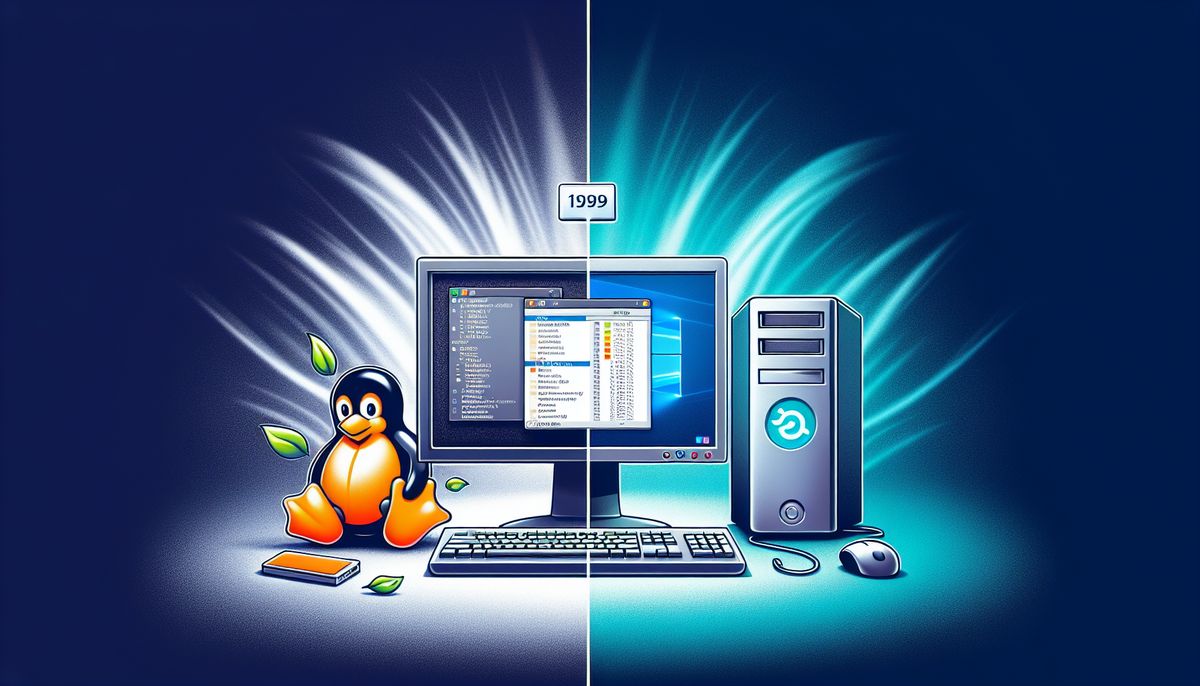With Windows 10 support officially ending in 2025, users are faced with a critical decision: upgrade to Windows 11, which often requires new hardware (I7 processor or up among other things), or consider alternative operating systems like Linux. Given the high costs and hardware requirements of Windows 11, many are seeing this as the perfect opportunity to switch to Linux, a cost-effective and versatile solution.
Key Takeaways
- Windows 10 support will end in 2025, pushing users to upgrade to Windows 11 or switch to another OS.
- Upgrading to Windows 11 can be expensive due to new hardware requirements and licensing fees.
- Linux offers a free and open-source alternative with lower hardware requirements and no licensing fees.
- Switching to Linux is made easier with user-friendly distributions, community support, and dual-booting options.
- Linux provides robust security benefits, including fewer vulnerabilities and regular updates.
Why Windows 10 Support Ending is a Big Deal
Impact on Security
When Windows 10 support ends on October 14, 2025, users will no longer receive crucial security updates. This leaves systems vulnerable to new threats and exploits. Without these updates, even minor vulnerabilities can be exploited by hackers, putting personal and business data at risk.
Compatibility Issues
As software developers focus on newer operating systems, older versions like Windows 10 will face increasing compatibility issues. New applications and updates may not work properly, leading to a frustrating user experience. Over time, this can make it difficult to use essential software and services.
User Experience
The end of support for Windows 10 means no more bug fixes or performance improvements. Users may encounter more frequent crashes and system slowdowns. This can significantly impact productivity and overall satisfaction with the operating system.
With the end of support for Windows 10, it’s crucial to consider alternatives that offer ongoing updates and support. This ensures a secure and efficient computing experience.
The High Costs of Upgrading to Windows 11

Upgrading to Windows 11 isn’t just a simple software update; it comes with a host of hidden costs that can catch users off guard. The hardware requirements alone are enough to make many reconsider. Let’s break down the key areas where these costs can add up.
Why Linux is a Cost-Effective Alternative
Switching to Linux can be a game-changer for those looking to save money without sacrificing performance. Open-source software provides a free alternative to commercially-produced programs, perfect for businesses and individuals with limited funds. But it’s not just about the software; the hardware requirements for Linux are generally lower, meaning you can get more life out of your existing devices or even opt for refurbished computers.
Free and Open Source
One of the most compelling reasons to switch to Linux is that it’s free and open-source. This means you don’t have to worry about licensing fees, which can be a significant expense for both individuals and businesses. Plus, the open-source nature of Linux allows for a high degree of customization, so you can tailor the operating system to meet your specific needs.
Lower Hardware Requirements
Linux is known for its efficiency and can run smoothly on older hardware. This is a huge advantage if you’re using Omaha used laptops or refurbished desktop computers. You don’t need the latest and greatest hardware to get good performance, making it a cost-effective choice for those looking to extend the life of their existing devices.
No Licensing Fees
Unlike Windows, which requires a paid license, Linux is completely free to use. This can result in substantial savings, especially for businesses that need to install the operating system on multiple machines. With no licensing fees, you can allocate your budget to other important areas, like upgrading your computer printers or investing in additional refurbished laptops.
Making the switch to Linux can be a smart financial move, especially when considering the high costs associated with upgrading to Windows 11. With lower hardware requirements and no licensing fees, Linux offers a cost-effective alternative that doesn’t compromise on performance.
Ease of Transition: Switching from Windows to Linux
Switching from Windows to Linux might seem like a daunting task, but it’s much easier than most people think. The key is to do a bit of research and find the right distribution that suits your needs. Most Linux distributions can be run as Live systems, which means you can test them out without affecting your current data.
User-Friendly Distributions
There are several Linux distributions designed specifically for new users. These distributions come with user-friendly interfaces and plenty of support to make the transition smoother. Some popular choices include Ubuntu, Linux Mint, and Fedora. These distros offer a familiar environment for those migrating from Windows.
Community Support
One of the greatest strengths of Linux is its community. There are countless forums, blogs, and online resources where you can find help and advice. Whether you’re troubleshooting an issue or looking for tips on how to customize your system, the community is always there to assist you.
Dual Booting Options
If you’re not ready to fully commit to Linux, you can set up a dual-boot system. This allows you to keep Windows on your machine while also having Linux installed. You can choose which operating system to boot into when you start your computer. This way, you can gradually get used to Linux while still having access to Windows when needed.
Moving away from the RHEL-based ecosystem might appear daunting, but if you’re considering Ubuntu, the switch can be both straightforward and economically viable.
In summary, transitioning to Linux doesn’t have to be a big jump. With the right distribution, community support, and the option to dual boot, you can make the switch smoothly and confidently.
Linux Distributions to Consider
When considering a switch to Linux, it’s essential to choose a distribution that fits your needs. Most Linux distributions can be run as Live systems, allowing you to test them without affecting your current data. Here are some popular options to consider:
Ubuntu
Ubuntu is one of the most user-friendly distributions available. It’s backed by Canonical and comes in both free and paid versions. The paid version offers more features and support, making it a great choice for both beginners and advanced users.
Linux Mint
Linux Mint is another excellent option, especially for those transitioning from Windows. It offers a familiar interface and a suite of software for office and internet use. It’s designed to be easy to use while providing a robust and reliable experience.
Fedora
Fedora is known for its cutting-edge features and regular updates. It’s a favorite among developers and tech enthusiasts who want the latest and greatest in open-source software. Fedora’s community support is also top-notch, making it a solid choice for those who like to tinker and customize their system.
Switching to Linux might seem daunting, but with the right distribution, it can be a smooth and rewarding experience.
Zorin
Zorin OS is known for its ease of use when transitioning from Linux. Based on Ubuntu, the look and feel is Windows out of the box. They offer great support including forums, a sub-Reddit, or direct support from the Zorin staff (with the purchase of Zorin Pro).
Software Alternatives on Linux

Switching to Linux doesn’t mean you have to give up your favorite software. There are plenty of great alternatives available that can meet your needs, whether you’re working on documents, designing graphics, or even gaming.
Office Suites
For those who rely on office software, LibreOffice is a fantastic replacement for the ever-changing and often overpriced MS Office. It offers a comprehensive suite of tools for word processing, spreadsheets, and presentations. If you can’t bear to part with Office 365, you can still use it via the web on Linux.
Graphic Design Tools
Graphic designers will find that Linux has several powerful tools. GIMP is a robust alternative to Photoshop, offering a wide range of features for photo editing and graphic design. Inkscape is another excellent option for vector graphics, comparable to Adobe Illustrator.
Gaming on Linux
Gaming on Linux has come a long way. Thanks to platforms like Steam and tools like Proton, many popular games are now playable on Linux. While not every game is available, the list of compatible titles is growing rapidly. For those who enjoy retro gaming, emulators are also readily available.
With the support of Omaha Computing Solutions, transitioning to Linux can be a smooth and rewarding experience. Whether you’re using new or used desktops, there’s a Linux solution for you.
Switching to Linux doesn’t mean sacrificing functionality. With a bit of exploration, you’ll find that Linux offers a rich ecosystem of software alternatives to meet your needs.
Security Benefits of Using Linux
Fewer Vulnerabilities
Linux systems are known for having fewer vulnerabilities compared to other operating systems. This is largely due to the open-source nature of Linux, which allows for constant scrutiny and quick patching of any discovered issues. Fewer vulnerabilities mean a more secure environment for users.
Regular Updates
One of the standout features of Linux is its regular updates. These updates are not only frequent but also easy to install, ensuring that your system is always up to date with the latest security patches. This proactive approach helps in maintaining a secure system.
Open Source Transparency
The open-source nature of Linux provides a level of transparency that is unmatched by proprietary systems. Users and developers can inspect the code, identify potential issues, and contribute to its improvement. This transparency fosters a community-driven approach to security, making it a robust choice for those concerned about their system’s safety.
With Linux, users can relish never having to deal with the complexities and vulnerabilities often associated with other operating systems. The community-driven approach ensures that the system is always up to date and secure.
Customizing Your Linux Experience

One of the most exciting aspects of using Linux is the ability to tailor your desktop environment to your liking. Whether you prefer a minimalist setup or a feature-rich interface, Linux has you covered. Customizing your Linux experience can be both fun and rewarding, allowing you to create a workspace that truly fits your needs.
Real-World Success Stories
Businesses Switching to Linux
Many businesses have successfully transitioned to Linux, enjoying benefits like reduced costs and enhanced security. For instance, a mid-sized tech company reported saving thousands of dollars annually by eliminating licensing fees and opting for open-source software. Their IT team also noted a significant decrease in system vulnerabilities.
Individual User Experiences
Individual users have also found Linux to be a reliable and efficient alternative to Windows. One user shared how switching to Linux Mint improved their computer’s performance, making it faster and more responsive. They appreciated the extensive customization options and the active community support.
Educational Institutions Adopting Linux
Educational institutions are increasingly adopting Linux to provide students with a robust and versatile learning environment. A university in California transitioned its computer labs to Ubuntu, resulting in lower maintenance costs and a more stable system for students and faculty. The move also allowed the institution to allocate funds to other critical areas.
The success stories of businesses, individuals, and educational institutions highlight the practical benefits of switching to Linux, making it a compelling choice for those looking to move away from Windows.
Common Myths About Linux Debunked

Linux is Hard to Use
One of the most persistent myths about Linux is that it’s difficult to use. While this may have been true in the past, modern Linux distributions have made significant strides in user-friendliness. User-friendly distributions like Ubuntu and Linux Mint offer intuitive interfaces that are easy to navigate, even for beginners.
Lack of Software
Another common misconception is that Linux lacks software. In reality, there are numerous high-quality applications available for Linux, many of which are free and open-source. From office suites to graphic design tools, Linux has a wide range of software to meet most users’ needs.
Poor Hardware Support
Many people believe that Linux has poor hardware support, especially for peripherals like printers and Wi-Fi adapters. However, hardware support has improved dramatically over the years. Most modern hardware is compatible with Linux, and there are extensive online resources to help troubleshoot any issues that may arise.
It’s important to debunk these myths to give Linux a fair chance as a viable alternative to Windows.
Summary
- Linux is Hard to Use: Modern distributions are user-friendly.
- Lack of Software: Plenty of high-quality, free applications are available.
- Poor Hardware Support: Compatibility has improved significantly.
Getting Started with Linux
Choosing the Right Distribution
Switching to Linux might seem daunting, but it’s easier than you think. The first step is to choose the right distribution. For beginners, Linux Mint, Pop!_OS, or Zorin OS are highly recommended. These distributions offer a user-friendly experience and are more familiar to users coming from Windows.
Installation Guides
Once you’ve chosen your distribution, the next step is installation. Most Linux distributions can be run as Live systems, allowing you to test them without affecting your current data. Follow the installation guides provided by the distribution’s website for a smooth setup process.
Learning Resources
Learning Linux can be a fun and rewarding experience. There are plenty of resources available online to help you get started. From forums and community support to detailed tutorials, you’ll find everything you need to become proficient in Linux. Remember, the most important thing is to search the Internet for articles and guides that can help you along the way.
Making the switch to Linux requires some research and effort, but the benefits are well worth it. With the right resources and a bit of patience, you’ll find that Linux is a powerful and flexible operating system that can meet all your needs.
Final Thoughts
As the end of support for Windows 10 approaches in 2025, users are faced with a critical decision: upgrade to Windows 11, which may require new hardware, or explore alternative operating systems like Linux. Given the cost-effectiveness and flexibility of Linux distributions such as Linux Mint and Zorin, now is an opportune time to consider making the switch. Linux offers a robust and secure environment that can breathe new life into older hardware, making it a viable option for many. Whether you’re tech-savvy or just looking for a cost-effective solution, transitioning to Linux could be the perfect move to ensure your computing needs are met without breaking the bank. So why not take this opportunity to explore what Linux has to offer?
Frequently Asked Questions
Why is Windows 10 support ending a big deal?
With the end of support for Windows 10, users will no longer receive security updates, which makes their systems vulnerable to new threats. Additionally, there will be compatibility issues with newer software and hardware, and an overall decline in user experience.
What are the high costs associated with upgrading to Windows 11?
Upgrading to Windows 11 can be costly due to the need for newer hardware that meets the system requirements, potential software compatibility issues, and licensing fees.
Is Linux really a cost-effective alternative to Windows 11?
Yes, Linux is a cost-effective alternative as it is free (Zorin Pro is under $50 as of this post) and open-source, has lower hardware requirements, and does not require licensing fees.
How easy is it to transition from Windows to Linux?
Transitioning from Windows to Linux is easier than ever with user-friendly distributions, strong community support, and options for dual booting to keep both operating systems.
What are some Linux distributions to consider?
Some popular Linux distributions to consider are Ubuntu, Linux Mint, Zorin, and Fedora. Each offers unique features and user experiences.
Are there software alternatives on Linux for common Windows applications?
Yes, there are many software alternatives on Linux, such as LibreOffice for office suites, GIMP for graphic design, and Steam for gaming.
What are the security benefits of using Linux?
Linux is known for its security benefits, including fewer vulnerabilities, regular updates, and the transparency of open-source code.
How can I customize my Linux experience?
You can customize your Linux experience with various desktop environments, themes, extensions, and system tweaks to suit your preferences.








